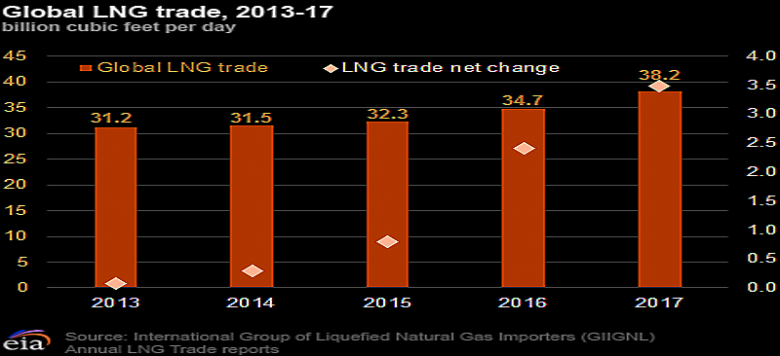
GLOBAL LNG TRADE UP 10%

EIA - Global trade in liquefied natural gas (LNG) increased by 3.5 billion cubic feet per day (Bcf/d) to 38.2 Bcf/d in 2017, a 10% increase from 2016 and the largest annual increase in the history of LNG trade. In 2017, there were 19 LNG-exporting countries and 40 LNG-importing countries. Malta became the newest country to begin LNG imports in 2017.
Strong growth in LNG trade was supported by new liquefaction capacity commissioned in Australia, the United States, and Russia, which collectively added five new liquefaction trains (combined 3.4 Bcf/d capacity). The world's first floating liquefaction plant, Malaysia's PFLNG Satu (0.2 Bcf/d capacity), was also commissioned in 2017.
LNG exports from Australia and the United States accounted for more than three-quarters (2.7 Bcf/d) of the increase in global LNG exports in 2017 compared to 2016. Angola's Soyo LNG plant returned to stable production in 2017, exporting 0.36 Bcf/d, after being shut down in 2014–16 because of technical issues with the liquefaction train. LNG exports from Trinidad, which have been decreasing in the past few years because of upstream natural gas feedstock shortages, decreased only slightly in 2017 (by 3%), as some progress has been made to bring online new production fields supplying the project.
Asia led the growth in global LNG imports, accounting for 74% (2.6 Bcf/d) of the increase in 2017, with 8 out of 10 LNG-importing countries registering the increase. China had the largest growth in LNG imports globally, an increase of 1.5 Bcf/d (46%) year on year. China became the world's second largest LNG importer in 2017, overtaking South Korea, as government policies promoting coal-to-gas switching led to a record growth in natural gas imports. South Korea had the second-largest increase in LNG imports among Asian countries (by 0.5 Bcf/d, 11% year on year), as several nuclear plants were taken offline for extended maintenance. Continuing its trend to move toward more natural gas-fired power generation, LNG imports also increased in Pakistan (by 0.2 Bcf/d, 57% year on year), as the country commissioned its second Floating Storage and Regasification Unit (FSRU) at the port of Qasim.
LNG imports also increased in Europe, primarily in southern Europe (Spain, Italy, Portugal), where a hot summer and lack of hydroelectric generation contributed to the increase. LNG imports also increased in France (by 0.24 Bcf/d, 32% year on year) as the country's third regasification terminal entered commercial service in January 2017, and cold winter and weak renewables generation in the summer along with extended maintenance on several nuclear plants all contributed to increased demand for natural gas. The United Kingdom was one of only two countries in Europe where LNG imports declined in 2017 (by 0.34 Bcf/d, 35%) as lower winter heating demand from the residential sector and a strong wind generation output reduced the demand for natural gas.
LNG imports in South America (Brazil, Argentina, Chile, Colombia) remained essentially flat year on year. In North America, Mexico registered a slight increase in LNG imports (by 0.1 Bcf/d, 17%), as the country continued to rely on LNG supplies amid declining domestic production and construction delays in pipelines connecting the Mexican domestic grid to natural gas supply from the United States.
-----
Earlier:

2018, April, 25, 09:55:00
ASIA'S LNG DEMANDREUTERS - global liquefied natural gas (LNG) imports have risen 40 percent since 2015, to almost 40 billion cubic meters (bcm) a month. Growth accelerated in 2017, with imports up by a fifth, largely because of rising demand in China, but also in South Korea and Japan. |

2018, April, 23, 14:30:00
GLOBAL LNG IMPORTS UP 10%PLATTS - Global LNG imports in 2017 increased by nearly 10%, the highest annual growth rate since 2010, reaching 289.8 million mt, while expectations of an LNG surplus failed to materialize as rising imports into China contributed to balancing the market. |

2018, March, 28, 11:10:00
U.S. LNG EXPORTS UPEIA - U.S. exports of liquefied natural gas (LNG) reached 1.94 billion cubic feet per day (Bcf/d) in 2017, up from 0.5 Bcf/d in 2016. As LNG exports increased, shipments went to more destinations. U.S. LNG exports in 2017, all of which originated from Louisiana’s Sabine Pass liquefaction terminal, reached 25 countries. |

2018, February, 27, 13:45:00
GLOBAL LNG DEMAND UP TO 293 MTSHELL - The global liquefied natural gas (LNG) market has continued to defy expectations of many market observers, with demand growing by 29 million tonnes to 293 million tonnes in 2017, according to Shell’s annual LNG Outlook. Such strong growth in demand is consistent with Shell’s first LNG Outlook, published in 2017. Based on current demand projections, Shell sees potential for a supply shortage developing in mid-2020s, unless new LNG production project commitments are made soon. |

2018, February, 27, 13:40:00
CHINA'S LNG IMPORTS UP BY 46%EIA - China surpassed South Korea to become the world’s second-largest importer of liquefied natural gas (LNG) in 2017, according to data from IHS Markit and official Chinese government statistics. Chinese imports of LNG averaged 5 billion cubic feet per day (Bcf/d) in 2017, exceeded only by Japanese imports of 11 Bcf/d. Imports of LNG by China, driven by government policies designed to reduce air pollution, increased by 1.6 Bcf/d (46%) in 2017, with monthly imports reaching 7.8 Bcf/d in December. |

2018, January, 5, 23:35:00
LNG INVESTMENTS WILL UPBLOOMBERG - Energy companies will approve investments for more than 150 million tons a year of new supply capacity over the next four years, according to the report. By comparison, global consumption was 286 million tons in 2017. Projects in Qatar, Papua New Guinea, Russia and the U.S. are most economically appealing, followed by Mozambique, Australian expansion projects and an Alaskan mega-project. |

2018, January, 3, 15:50:00
CHINA'S LNG IMPORTS UP 48.4%PLATTS - Chinese imports of LNG in 2017 totaled 37.89 million mt, up 48.4% year on year, while imports by South Korea totaled 36.51 million mt, up 10.81% year on year. |














